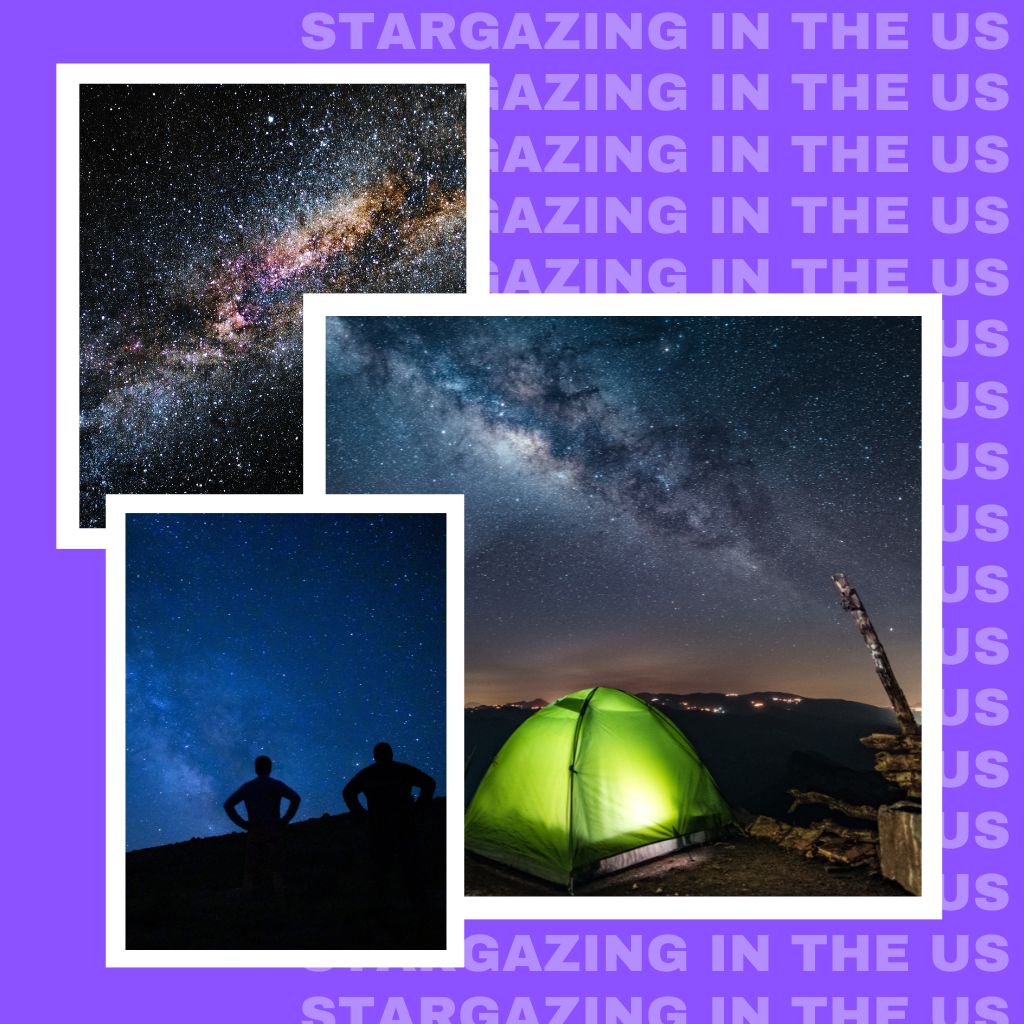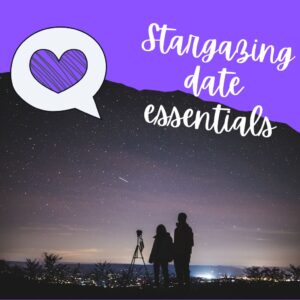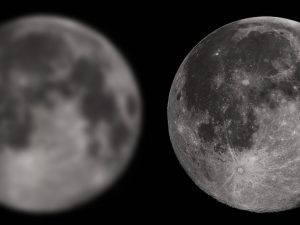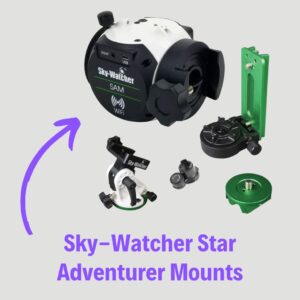This site contains affiliate links to products. I may receive a commission for purchases made through these links.
Light pollution is more than a mild inconvenience—it’s a curtain that veils the celestial wonders above us. With so many bright lights in our cities and endless streams of artificial lights, looking up to appreciate a starry sky has become something of a luxury.
Once-common sights like the Milky Way, constellations, and shooting stars are now elusive phenomena hidden behind the hazy glow of our modern world.
But not all is lost. The United States, with its diverse landscapes and vast open spaces, offers a myriad of locales where you can still view celestial objects. From remote deserts to high-altitude observatories, the US holds untapped sanctuaries that provide a front-row seat to the starry sky.
In this post, we’ll tell you about the 31 best stargazing locations in the U.S., where you can escape the city lights and reconnect with the cosmos.
1. Shenandoah National Park, Virginia
Shenandoah National Park in Virginia offers fairly dark skies. Its proximity to major cities makes it a convenient getaway for stargazers on the East Coast.
You can often see the Milky Way and various planets and star clusters. The park has several overlooks, providing elevated platforms for a better sky view.
2. Big Bend National Park, Texas
Big Bend National Park in southwest Texas offers one of North America’s darkest night skies, providing ample stargazing opportunities. Its remote location and over one million acres of land minimize light pollution, making it a haven for night sky enthusiasts.
In Big Bend, you’ll observe planets and even the elusive Andromeda Galaxy with the naked eye. The vast, open terrain offers panoramic views of the night sky.
A telescope like the Orion SkyQuest XT8 Dobsonian Telescope would be great for this location, especially for viewing distant galaxies and nebulae.
For the complete review, read: Orion SkyQuest XT8 Review (#1 Beginner Telescope)
3. Cherry Springs State Park, Pennsylvania
Cherry Springs State Park is another spot designated by the International Dark Sky Association. The park is located in Pennsylvania, a unique East Coast location that provides some of the darkest skies in the region.
Due to minimal light pollution, it has become a popular destination for stargazers.
You’ll easily spot the Milky Way, star clusters, and meteor showers with clear skies.
The park’s space is often used for star parties, where amateur astronomers gather to appreciate the night sky.
4. Great Basin National Park, Nevada
Great Basin National Park is located at a high elevation, allowing the park to experience dry conditions providing optimal clarity for sky-gazing.
Not only can you see the Milky Way in striking detail, but you’ll also get an unobstructed view of planets and constellations.
In addition, the park offers guided stargazing programs for those new to the hobby.
The Sky-Watcher Flextube 200 Dobsonian would blend well with the stargazing programs. It is highly recommended for its ease of use and ability to capture clear views of celestial bodies.
5. Glacier National Park, Montana
Glacier National Park in Montana is not just a stunning destination for its landscapes but also for its night skies. Close to the Canadian border and far from big cities, this national park offers dark skies perfect for stargazing.
The park offers one of the best chances in the lower 48 states to witness the aurora borealis.
You can see the Milky Way, northern lights, and meteor showers here, especially during late summer.
Its rugged terrain and hiking trails make it an adventurer’s dream, combining nature and astronomy.
6. Great Sand Dunes National Park, Colorado
Great Sand Dunes National Park in Colorado is famous for its towering dunes, but it also offers dark skies for stargazing. It boasts high elevation, ensuring crisp night sky views.
The light pollution is minimal, even though the park is relatively accessible compared to more remote locations.
The park’s tallest dunes offer a great vantage point for viewing the Milky Way, planets, and meteor showers.
Visitors can even sandboard down the dunes while waiting for the sky to darken.
7. Natural Bridges National Monument, Utah
Natural Bridges National Monument in Utah was the world’s first International Dark Sky Park, a designation it received in 2007. It offers some of the darkest skies in the country.
Due to its dry climate and remote location, the night sky here is remarkably clear.
You can spot the Milky Way arching over the park’s iconic stone bridges, making for incredible photographs.
Planets, star clusters, and occasional meteor showers also grace the sky.
The Celestron AstroMaster 130 EQ is a portable telescope that is easy to set up for your stargazing experience at this monument.
8. Acadia National Park, Maine
Acadia National Park in Maine offers a stunning sea and sky blend, making it a unique stargazing spot. Though not an International Dark Sky Park, it still offers fairly dark skies and is a popular destination for East Coast stargazers.
Here, the Milky Way, planets, and meteor showers are usually visible.
The park also offers various hiking trails, allowing you to find secluded spots for an intimate night with the stars.
9. Massacre Rim, Nevada
Massacre Rim in Nevada is an International Dark Sky Sanctuary, a designation recognizing its pristine night skies. Located near the border with Oregon, this sanctuary offers one of the darkest places for stargazing.
The remote location, over one million acres in size, minimizes light pollution to almost nil. The Milky Way is astonishingly bright here, and you can often see other galaxies, star clusters, and even planets.
Meteor showers are also frequent visitors to this dark sky sanctuary.
10. Cape Lookout National Seashore, North Carolina
Cape Lookout National Seashore in North Carolina is a unique East Coast location that offers pristine night skies over the Atlantic. Known for its Crystal Coast stargazers, the seashore provides a different experience with the reflection of stars over the ocean.
Visible celestial bodies include the Milky Way, star clusters, and some planets. On certain nights, meteor showers illuminate the sky, creating a magnificent spectacle over the water.
The Celestron NexStar 4SE Telescope is highly recommended for this seaside location. It is versatile and easy to use, ideal for observing the night sky.
To learn more about this telescope, read: Celestron NexStar 4SE Review (Read Before Purchasing)
11. Glacier National Park, Montana
Glacier National Park in Montana, close to the Canadian border, offers incredibly dark skies, making it a gold-tier International Dark Sky Park. The park provides stargazing opportunities and the chance to witness the aurora borealis.
Its hiking trails are a bonus for adventure enthusiasts who combine their stargazing with daytime outdoor activities.
You can observe the Milky Way, various constellations, and meteor showers here.
In winter, the Northern Lights occasionally make a dramatic appearance.
12. Gila National Forest, New Mexico
Gila National Forest in New Mexico is one of the best places to stargaze, offering over one million acres of land to explore. The forest has very low light pollution and offers clear skies most of the year.
You can expect to see the Milky Way, various planets, and star clusters. During certain times, meteor showers provide an extra magic touch to the already stunning sky.
13. Big Sky Country, Montana
Known as Big Sky Country, Montana offers various stargazing spots throughout the state. Though not officially designated by the International Dark Sky Association, the state offers some of the darkest skies in the nation due to its expansive, sparsely populated areas.
You can enjoy unobstructed views of the Milky Way, star clusters, and, on rare occasions, the Northern Lights. Meteor showers are also common sights in this part of the country.
The Celestron StarSense Explorer 8-inch Dobsonian will be ideal if you’re visiting Big Sky Country. It provides a powerful yet easy-to-use way to explore the night sky.
Read also: StarSense Telescopes: A Detailed Overview of the Collection
14. Foster State Park, Georgia
Foster State Park in Georgia is a less-known but remarkable spot for stargazing. The park offers impressive views due to its relative isolation and lack of nearby urban light pollution.
Foster State Park also hosts star parties where people can gather to observe the night sky. You can view the Milky Way, planets, and various star clusters. The park’s open fields offer an unobstructed view of the sky.
15. Joshua Tree National Park, California
Joshua Tree National Park in California is known for its surreal landscapes, but it’s also a dark sky park. The park is located at a high elevation and offers clear skies, ideal for astronomy.
You can expect to see the Milky Way, various constellations, and even some planets.
Joshua Tree also offers guided stargazing programs for amateur astronomers or those who want to learn more.
The Celestron PowerSeeker 127EQ Telescope is a good fit here. You can find and focus on specific celestial bodies easily.
Read the full review: Celestron PowerSeeker 127EQ Review (Before Purchasing)
16. Chaco Culture National Historical Park, New Mexico
Chaco Culture National Historical Park in New Mexico is an International Dark Sky Park with an on-site astronomy field, providing additional facilities for sky-gazing.
You can expect to see a bright and detailed Milky Way, various planets, and frequent meteor showers. The combination of ancient ruins and starry skies makes this location unique for historical and astronomical exploration.
17. Katahdin Woods and Waters National Monument, Maine
Katahdin Woods and Waters National Monument in Maine is an East Coast gem for stargazers. It offers some of the best night skies in this region. The monument provides excellent stargazing opportunities despite its proximity to populated areas.
You can see the Milky Way in fine detail, star clusters, and meteor showers. In the colder months, the Northern Lights make an occasional appearance.
The Orion 09007 SpaceProbe 130ST Equatorial Reflector Telescope would be a perfect choice here, as it offers both power and portability for capturing the Northern Lights or distant star clusters.
18. Bryce Canyon National Park, Utah
Bryce Canyon National Park in Utah is well-known for its otherworldly geological formations. However, it’s also a designated International Dark Sky Park.
The high elevation and dry climate contribute to its dark skies. You’ll see star trails, various constellations, and even distant galaxies on a clear night. The park often conducts night sky programs, giving visitors a more informed and enriching experience.
19. Death Valley National Park, California
Death Valley National Park in California has one of the darkest skies you’ll find in the country. It was designated as an International Dark Sky Park in 2013. This national park offers clear skies due to its arid climate and isolation.
The Milky Way appears so vivid that it can cast a shadow here. On a clear night, you’ll also see various planets, star clusters, and meteor showers.
For those deeply invested in stargazing, the Celestron NexStar 8SE Telescope is the perfect companion for your adventure here. It is capable of providing breathtaking views of deep-sky objects in detail.
Read the complete review: Celestron NexStar 8SE Telescope Review (Read Before Purchase)
20. Mount Rainier National Park, Washington
Mount Rainier National Park in Washington State is another locale not yet designated among international dark sky places but offers excellent conditions for stargazing.
The park is home to Mount Rainier, the highest peak in the state, providing elevated vantage points for sky observation.
Notably, you can sand board down some of the snowy slopes while waiting for the sky to darken, turning your stargazing trip into a multi-adventure outing.
In the dark skies above, you’ll spot the Milky Way, constellations, and even the occasional planet. State parks nearby also offer alternative locations, but the grandeur of Mount Rainier’s night sky is difficult to surpass.
Discover 11 other best stargazing locations in the US
21. Denali National Park, Alaska
22. Everglades National Park, Florida
23. Grand Canyon-Parashant National Monument, Arizona
24. Cuyahoga Valley National Park, Ohio
25. Capitol Reef National Park, Utah
26. Badlands National Park, South Dakota
27. Guadalupe Mountains National Park, Texas
28. Olympic National Park, Washington
29. Craters of the Moon National Monument, Idaho
30. Canyonlands National Park, Utah
31. Haleakalā National Park, Hawaii
Takeaway: Escape light pollution and savor the starry skies at these 31 best stargazing locations in the US
From the eerie landscapes of Death Valley National Park to the celestial reflections on the waters of Cape Lookout National Seashore, America’s night skies offer a canvas of unparalleled beauty.
Whether you’re a seasoned astronomer or a casual star-gazer, these locations offer something special. Some provide guided stargazing programs, star parties, or even astronomy fields to enrich your experience.
You may also like:












